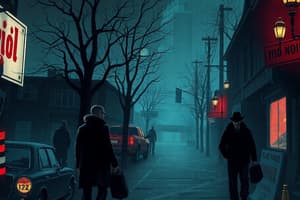Podcast
Questions and Answers
The first film ever made was ______ Garden Scene (1888) by Louis Le Prince.
The first film ever made was ______ Garden Scene (1888) by Louis Le Prince.
Roundhay
The ______ film era was characterized by the use of Charlie Chaplin, Buster Keaton, and Harold Lloyd.
The ______ film era was characterized by the use of Charlie Chaplin, Buster Keaton, and Harold Lloyd.
silent
The introduction of sound in film began with the movie ______ Singer (1927) by Warner Bros.
The introduction of sound in film began with the movie ______ Singer (1927) by Warner Bros.
The Jazz
In film production, ______ involves scriptwriting, casting, and location scouting.
In film production, ______ involves scriptwriting, casting, and location scouting.
A ______ shot is a camera angle that captures a character's face or object in close detail.
A ______ shot is a camera angle that captures a character's face or object in close detail.
The ______ Film Festival is a major event in the film industry, held annually in Utah.
The ______ Film Festival is a major event in the film industry, held annually in Utah.
Flashcards are hidden until you start studying
Study Notes
Film History
- The first film ever made: "Roundhay Garden Scene" (1888) by Louis Le Prince
- Early film pioneers: Thomas Edison, William Kennedy Dickson, Auguste and Louis Lumière
- Silent film era (1890s-1920s): Charlie Chaplin, Buster Keaton, Harold Lloyd
- Introduction of sound: "The Jazz Singer" (1927) by Warner Bros.
Film Genres
- Action: fast-paced, high-energy, often with stunts and special effects
- Comedy: humorous, light-hearted, often with satire or irony
- Drama: serious, emotional, often with character development
- Horror: frightening, suspenseful, often with supernatural elements
- Romance: emotional, sentimental, often with romantic relationships
Film Production
- Pre-production: scriptwriting, casting, location scouting, budgeting
- Production: filming, cinematography, lighting, sound recording
- Post-production: editing, visual effects, sound design, music composition
- Distribution: marketing, release, exhibition
Film Techniques
- Camera angles: close-up, medium shot, long shot, over-the-shoulder
- Camera movements: pan, tilt, dolly, tracking
- Lighting: natural, artificial, high-key, low-key
- Editing: cut, fade, dissolve, montage
Film Industry
- Major film studios: Warner Bros., Universal, Paramount, Disney, Sony
- Independent film: low-budget, outside of mainstream studios
- Film festivals: Sundance, Cannes, Toronto, Oscars
Film History
- The first film ever made is "Roundhay Garden Scene" (1888) by Louis Le Prince, lasting 2.11 seconds.
- Early film pioneers include Thomas Edison, who invented the kinetograph, and William Kennedy Dickson, who developed the kinetophone.
- The Lumière brothers, Auguste and Louis, held the first public screening of a motion picture in 1895.
- The silent film era (1890s-1920s) was marked by the rise of comedians Charlie Chaplin, Buster Keaton, and Harold Lloyd.
- Sound was introduced in films with "The Jazz Singer" (1927) by Warner Bros., revolutionizing the industry.
Film Genres
- Action films are characterized by fast-paced, high-energy sequences, often featuring stunts and special effects.
- Comedies are humorous and light-hearted, frequently incorporating satire or irony.
- Dramas are serious and emotional, focusing on character development and complex storylines.
- Horror films are frightening and suspenseful, often featuring supernatural elements.
- Romance films are emotional and sentimental, centering on romantic relationships.
Film Production
- Pre-production involves scriptwriting, casting, location scouting, and budgeting to prepare for filming.
- Production encompasses the actual filming, including cinematography, lighting, and sound recording.
- Post-production consists of editing, visual effects, sound design, and music composition to refine the film.
- Distribution involves marketing, releasing, and exhibiting the film to the public.
Film Techniques
- Camera angles include close-up, medium shot, and long shot, as well as over-the-shoulder shots.
- Camera movements can be panning, tilting, dollying, or tracking to create dynamic scenes.
- Lighting techniques can be natural or artificial, with high-key and low-key lighting used to create mood and atmosphere.
- Editing techniques include cutting, fading, dissolving, and montage to convey narrative and emotion.
Film Industry
- Major film studios such as Warner Bros., Universal, Paramount, Disney, and Sony dominate the industry.
- Independent films are made on a low budget, outside of mainstream studios, often with a more personal or niche focus.
- Film festivals like Sundance, Cannes, Toronto, and the Oscars showcase new and innovative films.
Studying That Suits You
Use AI to generate personalized quizzes and flashcards to suit your learning preferences.





